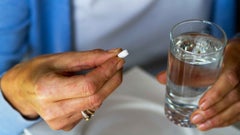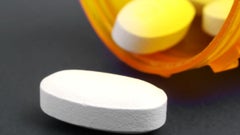
timolol
Timolol is an eye drop medication that's used to lower pressure within the eye and treat glaucoma. This medication belongs to the drug class called beta blockers. Timolol can be used by itself or together with other eye drops. The usual dosage is a drop of timolol into the eye(s) once or twice a day. Common side effects include burning or stinging after you put in the eye drops, but this is generally a temporary feeling. Although the brand name Timoptic was discontinued, the generic version is still available.

What is Timolol?
What is Timolol used for?
High pressure in the eye caused by ocular hypertension (high pressure inside the eye) or open-angle glaucoma (the most common type of glaucoma)
How Timolol works
Timolol is a beta blocker that lowers the amount of fluid in the eye. When there's less fluid inside the eye, the eye pressure goes down.
Drug Facts

Get your GoodRx coupon

What are the side effects of Timolol?
Common Side Effects
- Temporary burning or stinging in the eye after using
Other Side Effects
- Red eyes
- Crusty lashes
- Eye pain
- Feeling like there's something in your eye
- Itchy eyes
- More tears than usual
- Changes in vision (e.g., double vision)
- Headache
- Dizziness
Serious Side Effects
- Trouble breathing: shortness of breath, wheezing, chest tightness
- Heart failure: shortness of breath; fatigue; swelling in the legs, ankles and feet
- Allergic reactions: rash around your eyes or face, closing of the throat, hives, swelling
Source: DailyMed
More on Timolol side effects
The following side effects have also been reported
Along with its needed effects, a medicine may cause some unwanted effects. Although not all of these side effects may occur, if they do occur they may need medical attention.
Check with your doctor immediately if any of the following side effects occur:
More common
Chest pain or discomfort
lightheadedness, dizziness, or fainting
shortness of breath
slow or irregular heartbeat
unusual tiredness
Rare
Noisy breathing
small clicking, bubbling, or rattling sounds in the lung when listening with a stethoscope
swelling of hands, ankles, feet, or lower legs
Get emergency help immediately if any of the following symptoms of overdose occur:
Symptoms of overdose
Blurred vision
continuing ringing or buzzing or other unexplained noise in ears
headache
hearing loss
nervousness
pounding in the ears
sweating
Some side effects may occur that usually do not need medical attention. These side effects may go away during treatment as your body adjusts to the medicine. Also, your health care professional may be able to tell you about ways to prevent or reduce some of these side effects. Check with your health care professional if any of the following side effects continue or are bothersome or if you have any questions about them:
Rare
Acid or sour stomach
belching
burning, crawling, itching, numbness, prickling, "pins and needles", or tingling feelings
decreased interest in sexual intercourse
feeling of constant movement of self or surroundings
inability to have or keep an erection
indigestion
lack or loss of strength
loss in sexual ability, desire, drive, or performance
sensation of spinning
stomach discomfort, upset, or pain
Other side effects not listed may also occur in some patients. If you notice any other effects, check with your healthcare professional.
Call your doctor for medical advice about side effects. You may report side effects to the FDA at 1-800-FDA-1088.

Pros and cons of Timolol

Pros
Works well to treat high eye pressure
Usually only need to take once or twice daily
Lower-cost generic version available

Cons
Can cause some burning and stinging in the eye
Shouldn't use if you have asthma or other lung problems
Shouldn't take if you have uncontrolled heart failure, second- or third-degree heart block, or sinus bradycardia (a chronically low heart rate)

Pharmacist tips for Timolol

Wash your hands before putting timolol drops in your eyes. Don't let the dropper tip touch your eye or any other surface, and don't touch the tip with your hands. This will prevent the solution from getting contaminated with germs, which can help you avoid eye infections.
If you wear contacts, remove them before you use timolol. Then, wait 15 minutes to put your contacts back in your eyes.
After placing a drop of timolol in the eye, close your eye and press one finger to the inner corner of your eye by the nose and press lightly for 1 minute. This helps make sure your eye absorbs the drop.
If you have other eye drop medications that you need to use in addition to timolol, wait 10 minutes between each drop to give your eyes time to absorb each medication.
It's not easy to tell whether your eye pressure is improving at home. Make sure to use timolol as prescribed, even if you don't immediately notice any difference in your symptoms or vision.
Don't try to make the hole on the timolol bottle tip larger. The tip is made to pre-measure your drop, and making a larger hole can cause you to use too much medication.

Frequently asked questions about Timolol

How to save using GoodRx




What are the risks and warnings for Timolol?
Timolol can cause some serious health issues. This risk may be even higher for certain groups. If this worries you, talk to your doctor or pharmacist about other options.

Higher risk for heart failure
Risk factors: Congestive heart failure | Second- or third-degree heart block
In rare cases, some people developed heart failure while they used timolol. People who already have heart failure might be at risk for worsening heart problems with this medication. Tell your care team about your medical history. And talk to your provider if you notice swelling in your feet or ankles, a fast or irregular pulse, or shortness of breath when you lie down or exercise. These might be signs of heart problems.

Not recommended for people with breathing problems
Risk factors: History of asthma | History of chronic obstructive pulmonary disease (COPD) | History of other lung problems
Beta blocker medications like timolol usually aren't recommended for people with lung problems, such as asthma and COPD. This is because beta blockers can cause the airways to become narrower, which can make it harder to breathe. But the risk for breathing problems specifically with timolol isn't well known. Make sure your healthcare team knows if you have or have ever had any lung problems or conditions before you start using this medication to check whether it's safe for you.

Hidden symptoms of low blood sugar
Risk factors: Diabetes
Beta blockers can cause people with diabetes to not notice symptoms of low blood sugar, except for sweating and dizziness. It's possible for some timolol to be absorbed into your bloodstream and cause this effect. So though rare, it's important to be aware of this risk. Talk to your primary care provider to see whether you should check your blood sugar more often if you're using timolol.

Hidden symptoms of overactive thyroid
Beta blockers can cause people with an overactive thyroid to not recognize the signs of hyperthyroidism, such as a fast heart rate. It's possible for some timolol to be absorbed into your bloodstream and cause this effect. Although rare, it's good to be aware of this risk. Make sure your primary care provider knows whether you have thyroid problems before you start timolol.

Worsening of myasthenia gravis
In some rare cases, timolol can worsen symptoms like muscle weakness in people who have myasthenia gravis. Watch out for worsening symptoms if you have myasthenia gravis and let your care team know if this happens to you.

Timolol dosage forms

| Dosage | Quantity | Price as low as | Price per unit |
|---|---|---|---|
| 5ml of 0.25% | 1 eye dropper | $7.60 | $7.60 |
| 10ml of 0.25% | 1 eye dropper | $12.10 | $12.10 |
| 15ml of 0.25% | 1 eye dropper | $15.57 | $15.57 |
| 2.5ml of 0.5% | 1 eye dropper | $43.67 | $43.67 |
| 5ml of 0.5% | 1 eye dropper | $6.99 | $6.99 |
| 10ml of 0.5% | 1 eye dropper | $7.65 | $7.65 |
| 15ml of 0.5% | 1 eye dropper | $9.96 | $9.96 |
Typical dosing for Timolol
The typical dose is 1 drop into the affected eye(s) twice daily.
If your eye pressure comes down and stays down, your dose might be lowered to 1 drop in the affected eye(s) once a day.

Interactions between Timolol and other drugs
Using this medicine with any of the following medicines is usually not recommended, but may be required in some cases. If both medicines are prescribed together, your doctor may change the dose or how often you use one or both of the medicines.
- Albuterol
- Ceritinib
- Crizotinib
- Dronedarone
- Fenoldopam
- Fingolimod
- Formoterol
- Indacaterol
- Iobenguane I 131
- Iohexol
- Lacosamide
- Levalbuterol
- Olodaterol
- Oxymetazoline
- Paroxetine
- Ponesimod
- Rivastigmine
- Salmeterol
- Terbutaline
- Vilanterol
Using this medicine with any of the following medicines may cause an increased risk of certain side effects, but using both drugs may be the best treatment for you. If both medicines are prescribed together, your doctor may change the dose or how often you use one or both of the medicines.
- Aceclofenac
- Acemetacin
- Amtolmetin Guacil
- Aspirin
- Bromfenac
- Bufexamac
- Celecoxib
- Choline Salicylate
- Clonixin
- Dexibuprofen
- Dexketoprofen
- Diclofenac
- Diflunisal
- Dipyrone
- Droxicam
- Etodolac
- Etofenamate
- Etoricoxib
- Felbinac
- Fenoprofen
- Fepradinol
- Feprazone
- Floctafenine
- Flufenamic Acid
- Flurbiprofen
- Ibuprofen
- Indomethacin
- Ketoprofen
- Ketorolac
- Lornoxicam
- Loxoprofen
- Lumiracoxib
- Meclofenamate
- Mefenamic Acid
- Meloxicam
- Morniflumate
- Nabumetone
- Naproxen
- Nepafenac
- Niflumic Acid
- Nimesulide
- Nimesulide Beta Cyclodextrin
- Oxaprozin
- Oxyphenbutazone
- Parecoxib
- Phenylbutazone
- Piketoprofen
- Piroxicam
- Pranoprofen
- Proglumetacin
- Propyphenazone
- Proquazone
- Rofecoxib
- Salicylic Acid
- Salsalate
- Sodium Salicylate
- St John's Wort
- Sulindac
- Tenoxicam
- Tiaprofenic Acid
- Tolfenamic Acid
- Tolmetin
- Valdecoxib

How much does Timolol cost?

Timolol contraindications
Asthma
Sinus bradycardia (slow heart rate)
Second- or third-degree heart block

What are alternatives to Timolol?
High pressure in the eye caused by ocular hypertension (high pressure inside the eye) or open-angle glaucoma (the most common type of glaucoma)
High pressure in the eye caused by ocular hypertension (high pressure inside the eye) or open-angle glaucoma (the most common type of glaucoma)
High pressure in the eye caused by ocular hypertension (high blood pressure inside the eye) or open-angle glaucoma (the most common type of glaucoma)

What is the latest news about Timolol?

Timolol images
Get savings updates for Timolol
Receive price alerts, news, and other messages from GoodRx about Timolol and other healthcare topics and relevant savings offers.By providing your email, you consent to receive marketing communications from GoodRx, which may include content and/or data related to men’s health, women's health, reproductive care, or sexual health. You agree to the GoodRx Terms of Use and acknowledge the Privacy Policy. You can unsubscribe at any time.
References
Best studies we foundAmerican Optometric Association. (n.d.). Ocular hypertension.
Fosun Pharma USA Inc. (2024). Timolol maleate ophthalmic gel forming solution solution, gel forming / drops [package insert]. DailyMed.
Hafeez, Y., et al. (2023). Sinus bradycardia. StatPearls.
Higginbotham, E. J., et al. (2010). Fixed combination of latanoprost and timolol vs individual components for primary open-angle glaucoma or ocular hypertension: A randomized, double-masked study. Archives of Ophthalmology.
Huang, K. Y., et al. (2021). Do beta-adrenergic blocking agents increase asthma exacerbation? A network meta-analysis of randomized controlled trials. Scientific Reports.
Morales, D. R., et al. (2016). Respiratory effect of beta-blocker eye drops in asthma: population-based study and meta-analysis of clinical trials. British Journal of Clinical Pharmacology.
National Eye Institute. (2024). Glaucoma medicines.
National Eye Institute. (2024). How to put in eye drops.
National Eye Institute. (2023). Blepharitis.
National Heart, Lung, and Blood Institute. (2022). What is cardiogenic shock?
Rising Pharma Holdings, Inc. (2023). Timolol maleate solution/ drops [package insert]. DailyMed.
Sidjanin, D. J., et al. (2008). Pharmacogenetics of ophthalmic topical beta-blockers. Personalized Medicine.
U.S. Food and Drug Administration and Department of Health and Human Services. (2017). Determination that Timoptic (timolol maleate ophthalmic solution), 0.25 percent and 0.5 percent, was not withdrawn from sale for reasons of safety or effectiveness.
Compare other Migraine, Heart Attack, Hypertension, Glaucoma, Eye Pressure drugs
Browse medications
View AllResearch prescriptions and over-the-counter medications from A to Z, compare drug prices, and start saving.








